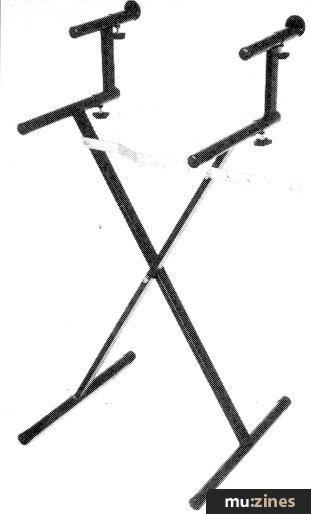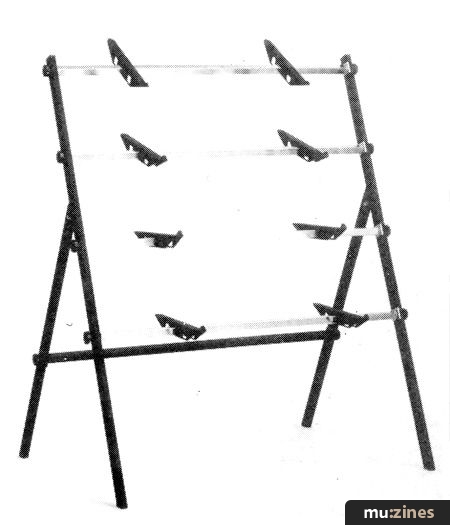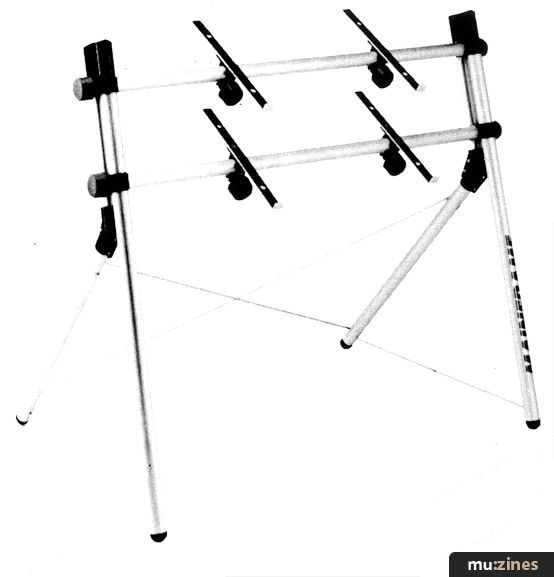Magazine Archive
Home -> Magazines -> Issues -> Articles in this issue -> View
Take a Stand | |
Article from Electronics & Music Maker, June 1985 | |
There's no point having a mass of electronic keyboards if you've got nothing to mount them on, but how many keyboard stands are available, and what do they offer? Trish McGrath stands up to the lot of them in an extensive survey.
It's estimated that the average keyboard player is willing to spend 10% of the cost of a synth setup on a stand to hold it all in place, yet nobody has attempted to survey what's available and how much it costs - until now.
I started off with a blank sheet of paper. There's been an almost total media silence about keyboard stands, so initially, my only source of information was the bundle of promotional literature I'd accumulated and the comments of friends.
Just what are the criteria you apply when choosing a keyboard stand, anyway? Is it just a matter of how many tiers it has? Evidently not. The interrogation of fellow staff members resulted in various other requirements coming to light (as well as some amazing disclosures that have absolutely nothing to do with keyboard stands...). Top of the list was, not unnaturally a suitable number of tiers; after all, there's not much use in buying a simple X-type stand if you're trying to accommodate three or four synths, or have plans to add to your lineup in the near future.
But there are a whole host of other considerations, too, like stability (will it topple over as you reach the high-point of your amazing solo?), reliability (will you need to wear reinforced boots to protect your toes from fast-descending keyboards?), durability of finish (will you have to repaint it after every gig?), weight (will you get a hernia just carrying it from gig to gig?), and sturdiness (is it made of a strong enough material not to buckle under a not inconsiderable weight?).
Then there's money. Not just simple value for money considerations, but, in this case, simply justification. Is it really worth lashing out £300 on something to hold three VL-Tones?
Finally, ease of setting-up does come into it, though just how much will depend on whether the stand is going to be stationary at a home or studio, or whether it'll be used regularly in gigging situations. In the latter case, bear in mind whether you'll need to assemble the thing singlehandedly or whether you've a couple of keyboard roadies with nothing to do other than set up stands for two hours before the soundcheck. Remember, also, that some stands incorporate a 'memory' feature that helps reduce setting-up time by letting you know where the various parts were positioned previously.
Generally, the fewer bits (and specialist tools needed for assembly) that can get mislaid, borrowed or left behind, the better.
Then there are the more specialist considerations peculiar to each individual. Can a freestanding keyboard such as a Rhodes or Electric Grand fit snugly below a couple of tiered synths (some stands come with extra long bars), and can the unit be adapted to provide a 'table top' for convenient placing of sequencers and drum machines? Can you buy extra-long support arms for unusually deep keyboards, and finally, does the manufacturer provide a carrying case for protection?
Standing Simply

The Yamaha YSX.
The most popular type of keyboard stand is the X-type, which can handle just the one keyboard or, with an extension fitted, a second one placed on top and slightly further back. With its perforated, height-adjusting horizontal bar, the X-type is utterly straightforward to set up, relatively inexpensive, and folds away without the need to store lots of bits and pieces. Unfortunately, it's also rather inflexible, and chances are that with two synths stacked up at once, the lower machine's front panel will be obscured from view.
Anyway, of the couple of X-types beamed to the office recently, the Yamaha YSX can be used as either a single or double stand, with two extension screw-on arms to provide optional, adjustable backrests to prevent the top synth from diving into the audience. It's good value at just £33, with maximum and minimum heights for the lower level being measured at 93cm and 61cm respectively, and the higher level just 18cm away. However, bear in mind that at maximum height, the width span of the stand is just 28cm - only really suitable for balancing drum machines and sequencers...
Biggest criticism we can make relates to the security of the top supports. These have a tendency to revolve - with potentially disastrous results - unless the relevant knobs are hand-tightened extremely well. And in any case, these do no more than simply grip the lower bar, so perhaps some grooving or the odd screw-in knob (you need a clean mind in this job...) could be usefully employed here.
And due to the stacking method employed, the knobs that grip the bars don't waste much time in scraping away the otherwise classy matt black finish. Pity, too, that the height-adjusting bar isn't treated to the same black paint job, but left bare to the elements. Don't tell me looks don't count...
Sola Sound, meanwhile, follow a slightly different route with their Eurotec Quickfold stands. Finished in scarcely startling black paint, they provide two extension arms which grip by means of a ball bearing to the insides of the lower supports, at a height of some 28cm above the main part of the stand. However, a telescopic horizontal rod connects to both extension arms, securing them in an upright position and minimising any risk of slippage. Nice one - though as the extension unit is finished in nickel plating, it does have the appearance of being something of an afterthought, rather than an integral part of the stand's design.
Eurotec X-type stands come in two sizes: Standard - max height 91cm (width 36cm), min height 62cm (width 76cm), RRP £25 or £40 with extension; and Large - max height 122cm, min 101cm, RRP £26.50 or £41.50 with extension.
Tiers are Not Enough

Eurotec's four-tier Multistand.
Of course, if you're either rich or your name is Keith Emerson, you'll probably be more interested in the multiple-tier arrangement, which generally combines immense flexibility, good posing value, and quite often, an appropriately grand price tag. Sadly, the high value of the dollar means the excellent Ultimate Support stands are no longer considered a viable proposition for UK importers, but there's been no shortage of other manufacturers eager to take their place.
We begin back at Sola Sound, who have a foot in this camp as well with their Eurotec MultiStands. These come in three- and four-tier versions (£103 and £114 respectively).
All tiers are fully adjustable in both height and angle of tilt, with a width span of 116cm, a maximum height of 146cm, and support arms measuring about 37cm deep. In other words, a standard sort of spec all round.
Comments? Well, although the stand as a whole seems perfectly stable, the support bars do wobble slightly and can't be fixed in a set position on the tier. The fittings are a little fiddly to connect together - and to my weak heart, not entirely foolproof.
Finished in a durable black crackle-finish with chrome cross pieces, the cheap 'n' cheerful MultiStand could be the answer to many an impecunious keyboardist's prayer, even though some of its features don't inspire confidence.
Eurotec also make a Double Keyboard Stand, with a width span of 100cm and fully-adjustable tiers and tilts. This version is more upright than the norm and should accommodate a piano-type instrument underneath its tiers more easily.

The Mainframe double-tier stand.
Honky Tonk Music pounced on us recently with their Mainframe keyboard stand, distributed in the UK by Key-Tech Musical Ltd. Designed and manufactured in Japan from lightweight aluminium tubing, the single and double tier stands retail at £79 and £99 respectively, with a 107cm leg and 107cm tier width. The support arms, at present available only in a 36cm depth, can be placed at any point along the tier and are secured with the help of two large knobs; but as these control the tilt as well as the position, you've got to take a lot of care in ensuring that you tighten them securely.
The three- and four-tier versions, at £149 and £165 respectively, closely resemble the basic version, though with inside leg measurements of 160cm, and wider 122cm tier widths. Although I enjoyed its company only briefly, the only hassle I found with the Mainframe stand was in getting the cross-braces to slot into position in the relevant holes in the legs. Let's just say that if the initial assembly instructions are anything to go by, I'm only glad the review sample reached our shores ready-assembled. But take heart - partial disassembly (for carting it from gig to gig) is pretty straightforward. It seems additional tiers will be made available soon at around £20 each, in addition to various sizes of support arms, so building a personalised modular system certainly seems a viable proposition.

Tama's KH210 double-tier stand.
Outstanding
But of all the models currently vying for supremacy in the keyboard stand stakes, it's Tama that seem to be closest to usurping Ultimate Support's crown in their absence! Arriving in the UK via Summerfield, the Tama KH range is constructed from lightweight but durable aluminium, and finished in a very attractive 'platinoid' (let's just call it a metallic gold, OK?).

Tama's unique 'memory key lock' feature.
Perhaps the most striking aspect of the Tama stand is the degree of thought which has so obviously gone into its design; probably a hangover, I would guess, from all those years building drum hardware... The support arms should be quite unslippable thanks to the 360-degree, two-point locking concept (ie. two grooves which stop the support arm rotating), and a handy 'memory key lock' feature means that you can preset the tilt of the support arms so that they 'remember' the desired angle from gig to gig. Another nice touch is the second bar unit supplied with the lowest tier; this is placed on the rear legs and should, with the aid of the longer 55cm arms, provide ample support for even the heaviest of today's gigging keyboards. Better still is the fact that this arrangement can be adapted for table usage, and we believe Tama will soon be stocking the table top, too.. What for? Well, you know the sequencer, the drum machine and the pint of lager that you never know quite where to position at a gig? Well, now you can place them strategically below the keyboards for easy access...
Getting down to the nitty gritty and the amount that'll be debited on your next Visa statement is a bit difficult with the Tama range, partly because there are no less than six different packages available, and partly because the prices we've been quoted are 'guideline' retail prices only.
Basically, there's a choice of two tier widths (110cm and 130cm), which can also be purchased separately at £45 and £48 respectively; a choice of two leg heights (108cm and 138cm); and the option to purchase additional support arms (either 40 or 55cm deep). The basic one-tier KS110 stand will set you back a cool £175 and weighs in at a sturdy 5.4kg. Prices and weights progress from there till you reach the three-tier KH330 stand at £305. The range is wide enough to accommodate just about every requirement, though curiously, Tama's publicity material makes no mention of a four-tier model.
By the way, securing of tiers and arms is carried out with an allen key (supplied), with replacements (for when you lose it, as you inevitably will) costing a modest £3 a go.
As is the case with so many modular concepts, the theme of the Tama range seems to be adaptability and flexibility - but I'd suggest studying the brochure and checking prices carefully, as now and again it seems to work out cheaper to go modular (ie. buying the basic stand and adding a bar unit). All I can add is that these stands are the biz...
There is, however, another impressive-looking stand we never quite managed to get our hands on. Model in question is the Prostand, handled by Sequential in Holland and currently filtering into the UK through a number of retail outlets (Argents, Sound Control, and London Rock Shop to name but three). At present, only the KS150 P package is readily available, and this consists of three tiers of 122cm in length, with support arms measuring 36cm; it comes complete with a waterproof PVC-coated carrying bag. The brochure makes mention of optional tier widths and longer support arms of 51cm - so we'll just have to wait and see.
The features of the KS150 suggest this is a very easy stand to erect, and the support bars can be fastened to the tiers in any of six holes, giving a wide (albeit not infinite) range of width choices - they should put a stop to sideways slippage, too.
Incidentally, one feature common to every multiple stand we've looked at is the provision for adjustment of the support arms' front-to-rear settings, to allow a greater degree of comfort in the placing of keyboards.
So, in spite of the media silence, it seems the keyboard stand market is in a healthy and active state of mind. We know of two British companies currently beavering away designing yet more high-quality stands, now that Ultimate Support are keeping a low profile. The first seems set to be titled the A-Frame, while the other will emerge from good ol' Sola Sound. Exact details, we know not. As for me, I'd best be gone before I bump into the little black square that's coming up...
Further information from:
Yamaha, (Contact Details).
Sola Sound, (Contact Details).
Honky Tonk Music, (Contact Details).
Key-Tech Musical Ltd. (Contact Details).
Summerfield, (Contact Details).
Sequential, (Contact Details).
Publisher: Electronics & Music Maker - Music Maker Publications (UK), Future Publishing.
The current copyright owner/s of this content may differ from the originally published copyright notice.
More details on copyright ownership...
Review by Trish McGrath
Previous article in this issue:
> Anvil Percussion Synthesiser...
Next article in this issue:
> MIDI FX
Help Support The Things You Love
mu:zines is the result of thousands of hours of effort, and will require many thousands more going forward to reach our goals of getting all this content online.
If you value this resource, you can support this project - it really helps!
Donations for April 2024
Issues donated this month: 0
New issues that have been donated or scanned for us this month.
Funds donated this month: £7.00
All donations and support are gratefully appreciated - thank you.
Magazines Needed - Can You Help?
Do you have any of these magazine issues?
If so, and you can donate, lend or scan them to help complete our archive, please get in touch via the Contribute page - thanks!






